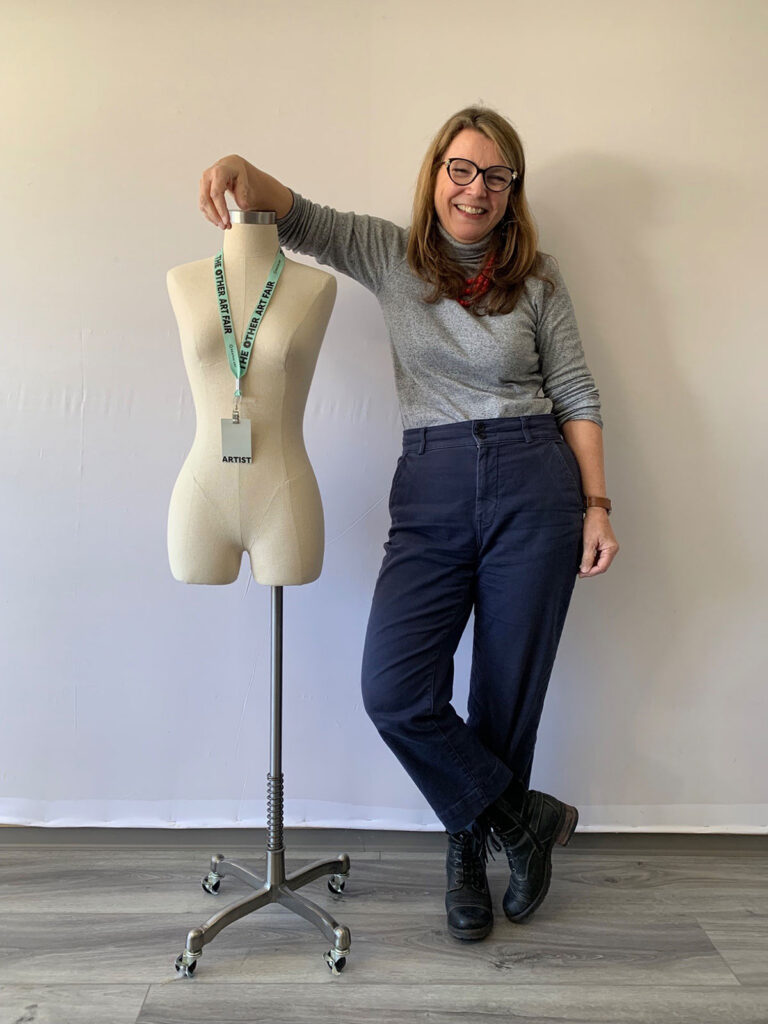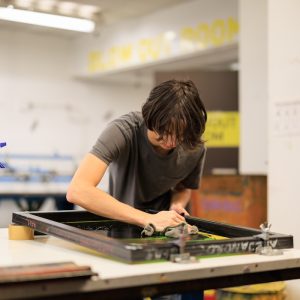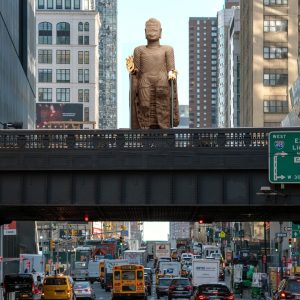The colorful, geometric, nature-inspired textile artworks by visual artist Nicki Voss (Art BFA 88, MFA 90) are thoughtful studies of material and composition, often reflecting her concerns about environmental sustainability, gender, the value of labor, and the interplay between art and everyday life. Voss’ intricate process of converting photographic images into textile pieces is deeply rooted in her background in collage and paper arts.
As a Los Angeles-based teaching artist, she is passionate about making art accessible and reviving basic manual skills in communities. Her workshops and classes aim to empower individuals through the creative process, reflecting her belief in the transformative power of art. With Textilepop, her retail and studio space in Old Town Newhall, and fresh from being spotlighted in Artful Home’s Artists’ Voices campaign, Voss is busy continuing to make her mark in the art community.
In May, she presented her work at Descanso Gardens for their Mother’s Day Botanic Boutique event, and later this month, she looks forward to contributing to the teaching artists exhibition Synthesis at Barnsdall Junior Arts Center Gallery in Los Angeles. The show opens July 20 and runs through Aug. 24.
In the following conversation with 24700, Voss shares her creative processes, her reflections on the intersection of art and utility, and her ongoing commitment to environmental consciousness in her art.

24700: Can you describe your journey from studying at CalArts to specializing in quilted textiles? How did your educational experiences influence your artistic direction?
Voss: My first mentor at CalArts was John Baldessari, followed by Connie Hatch, whose emphasis on feminism and women art-makers as disruptors resonated with me. Much of what I learned in her classes and from her mentorship continues to shape my inner art dialogue today. I also worked extensively with Michael Asher and was his TA in the legendary class Post Studio Art. Working with Michael will always remain a highlight for me; his encouragement and constant probing to go deeper and to continuously ask why, with respect to the idea, the choice of materials, and how a piece is realized, is a rigorous thought practice I follow to this day.
I don’t think of myself as an artist specializing in quilted textiles; I self-identify as a visual artist who works with textiles. The quilt medium is the vehicle for my explorations of landscape, gender, the value of labor, the assumptions of craft versus fine art, a love of fabric, and the joy of color. When I am working on a textile series, I view the quilt as the cloth messenger.
24700: What drew you to use quilts as a medium for expression, particularly with their dual function as both art and utility?
Voss: My mom taught me the basics of sewing when I was 5, and it went off from there. While I was a student at CalArts, I did use textiles a little bit in my earlier sculptural pieces, and I even took a class in the Costume Shop that was open to the Institute to see if that was a direction I wanted to explore.
During the high anxiety period of the pandemic, the concept of comfort as an art idea to explore began to resonate. It was on one of my outdoor morning walks that the image of wrapping yourself, literally enfolding yourself in a landscape, emerged. I wondered how I might do that, and the quilt as an artistic template suggested itself as the perfect vehicle. I love the duality of art and utility, and I absolutely lean into the shape-shifting dynamic of this textile art form; sometimes it’s this, and sometimes it’s that.

24700: Your work transitions from outdoor photography to quilt compositions. Could you walk us through how you transform a photographic image into a textile piece?
Voss: Logic and curiosity intermingle. Typically, a photograph that I’ve shot previously will begin to resonate with possibility as a quilted textile, and I’ll let the image germinate first to see if I’m intrigued enough to take it further. Or sometimes a location (a specific landscape composition) will emerge in my mind, and I can’t let go of the idea of what it might look like as a textile. The Mulholland Drive Quilt is a great example of that impulse, because I could already see the image in my mind and then intentionally scouted out the perfect view on Mulholland Drive.
I work organically and without the use of a computer or quilting software, methodically pinning and rearranging small pieces of fabric directly on the design wall in my studio until I instinctively feel that I have the color balance and composition right. This work in quilting evolved from my earlier collage work in paper, and there are similarities in how images are constructed, using geometry, layering, cutting, and positioning.

24700: Is there a particular place or environment that holds significant meaning for you and your artwork?
Voss: The Ancient Bristlecone Pine Forest in the White Mountains at an elevation of 10,000 feet near the California/Nevada border is one of the most spectacular locations in the world. Wood samples collected by scientists from the Bristlecone Pine Trees indicate that many are well over 4,500 years old.
The art piece that emerged from this visit was the Bristlecone Pine Tree Cloak. A wearable art cloak, the garment enables the wearer to become enveloped and transformed within the tree bark, ageless, powerful, and perhaps even omnipotent. In our consumer society, where women cease to be seen once they pass a certain age, it was powerful to witness that here, in nature, our timeline-construct is patently absurd. As a woman, it was validating. The Bristlecone Pine Tree Cloak embodies many of the concepts that I am exploring.
24700: Does environmental consciousness play a role in your artistic practices or choice of materials?
Voss: Absolutely, this is core. It is my decision to use and only work with natural fabric and materials in my quilt medium. When I first formed my small arts business in 2021, Textilepop, I signed up with 1% for the Planet as I believe in the circular pathway of businesses about the planet also contributing to the future of the planet; it rings with authenticity and a kind of a “put your money where your mouth is” proposition.
Equally, historically, quilting is all about repurposing material and turning something that was waste into something useful. Women did this for generations. It was economical and practical. It’s also the direct opposite of our have-it-all consumerism and fast-fashion world. Climate change is on my mind as I make this work, and I hope that the concept of literally and figuratively being enfolded by a landscape may resonate.
24700: Are there particular natural phenomena or landscapes you haven’t yet explored but plan to in future projects?
Voss: I’ve been thinking a lot about Zion and Bryce Canyon recently, as the rusty red rock colors are so distinct, and the color balance with the sky would be graphically striking. I’ll be spending time in Wyoming this summer where my intention is to take lots of photos; here I’m interested in the plains and the geography, and my avid interest in history is definitely activated. There are tragic histories there and incredible tenacity, too. Right now, that absolutely feels like a future project.
24700: Can you tell me a little bit about your workshops and how teaching fits into your practice?
Voss: I came into teaching relatively recently, and have been astonished to discover how much I enjoy it. Teaching at a community or entry level feels natural to me, as I am passionate about accessibility and access to skill-building, and it provides anyone who wants to learn something the opportunity. There’s real empowerment in the creative process, and I enjoy giving it away as much as I like to engage in it myself.
In addition to individual and group lessons at my studio in Newhall, I’ve taught for LA County Parks and Recreation, the city of Santa Clarita, at FIDM, and for the Los Angeles Department of Cultural Affairs as a teaching artist in Fiber Arts at Barnsdall Art Park. I hope to be able to expand the workshops over the coming months as well as collaborate on larger creative projects and commissions, from the broader CalArts community and beyond. I’m deeply invested in the idea of community.



